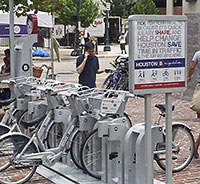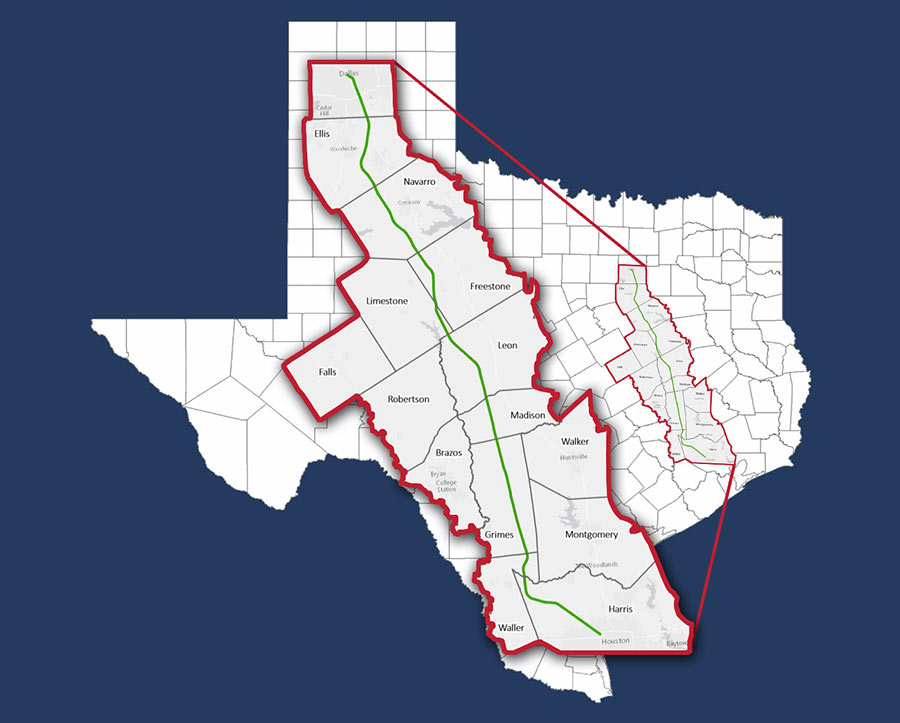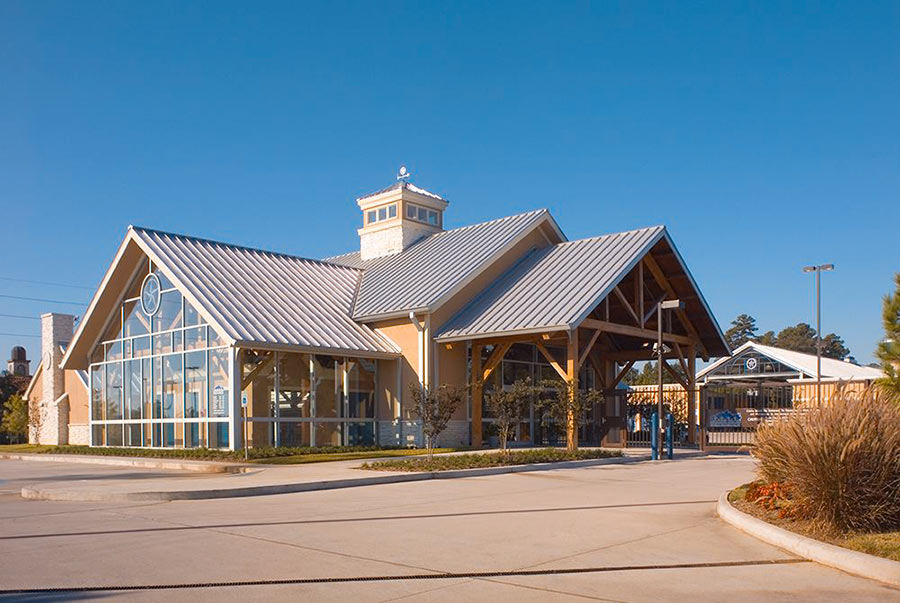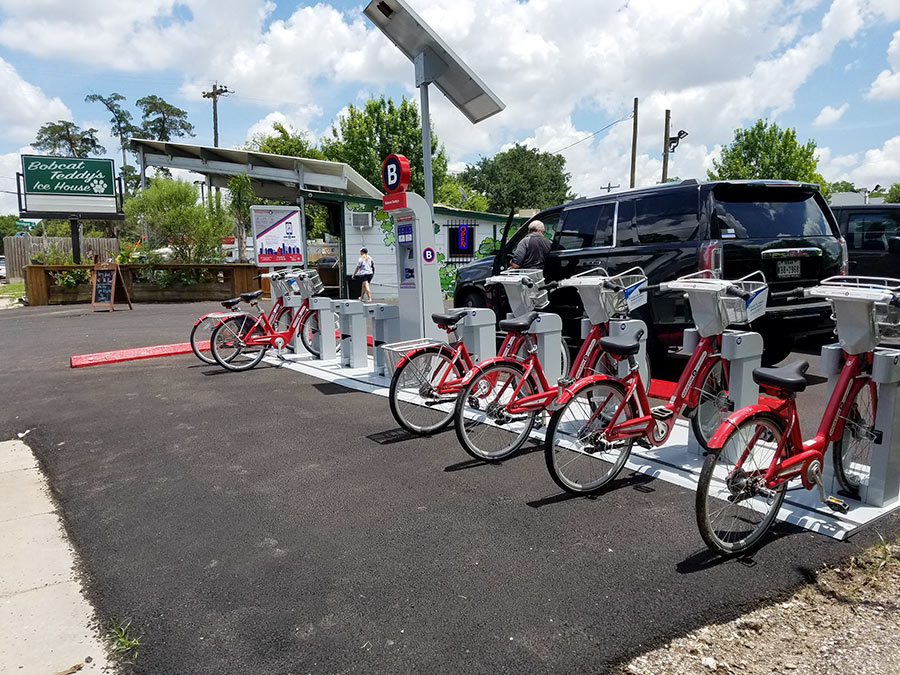ARE HOUSTON’S B-CYCLES ‘MERELY TOYS FOR URBAN BOHEMIANS’?  Houston has some 175 rent-a-bikes available at swipe-a-credit-card kiosks here and there in Midtown, Montrose, and Downtown, with plans to expand to the East End, Med Center, and universities soon. But an editorial yesterday from the Houston Chronicle seems to doubt that all these bikes are making much of a difference so far, pointedly wondering whether they represent “legitimate transportation or merely toys for urban bohemians. . . . After all, there are no B-Cycle stations in the poor neighborhoods surrounding downtown’s B-Cycle core. It is not as if these neighborhoods aren’t bike-friendly. The Fourth Ward is accessible by West Dallas St., a designated bike-share road that connects directly with downtown. And the Columbia Tap bicycle trail stretches from east of downtown through the Third Ward to Brays Bayou — one of the most convenient bicycle paths in the city, utterly wanting for a B-Cycle station.” [Houston Chronicle; previously on Swamplot] Photo of Market Square Park B-Cycle Station: Flickr user YMKM Agency
Houston has some 175 rent-a-bikes available at swipe-a-credit-card kiosks here and there in Midtown, Montrose, and Downtown, with plans to expand to the East End, Med Center, and universities soon. But an editorial yesterday from the Houston Chronicle seems to doubt that all these bikes are making much of a difference so far, pointedly wondering whether they represent “legitimate transportation or merely toys for urban bohemians. . . . After all, there are no B-Cycle stations in the poor neighborhoods surrounding downtown’s B-Cycle core. It is not as if these neighborhoods aren’t bike-friendly. The Fourth Ward is accessible by West Dallas St., a designated bike-share road that connects directly with downtown. And the Columbia Tap bicycle trail stretches from east of downtown through the Third Ward to Brays Bayou — one of the most convenient bicycle paths in the city, utterly wanting for a B-Cycle station.” [Houston Chronicle; previously on Swamplot] Photo of Market Square Park B-Cycle Station: Flickr user YMKM Agency





Was anybody naive enough to expect it any other way? Of course they’re just hipster toys.
—
How did the Hipster die? He drowned in the Mainstream!
I ride them a lot. I’m not a bohemian, but aren’t we all urban?
Do I count as an “urban Bohemian” if I live in Midtown and have Czech ancestors (https://en.wikipedia.org/wiki/Bohemia)?
I saw quite a few visitors using them downtown during the NBA all star weekend. I never thought they were supposed to be anything else but a novelty, if one really wants to bike they will buy their own.
Not sure they were meant as a transportation alternative for the poor. Especially when you factor in that you need a credit card to rent one, and rental rates are higher than bus fares.
Regardless, I dont understand the concern over who ends up using them when it’s an added amenity for tourists amd suburban families that don’t want to load up four bikes in a miniam when visiting the zoo or an art festival. And besides, the program pays for itself via use fees.
the program has to expand organically. bcycle’s budget only allowed for it to start with a certain amount of stations, and they all have to be clustered together. if some of the original stations started out on the east end or the heights, then there wouldn’t be very many places to dock the bikes, and they wouldn’t be very useful. hopefully, the program grows to those areas, but the stations have to be a bit more dense than you think.
Clearly these kiosks were aimed at the bike riders who do seem to belong to the “yuppie” class, which is more a cultural/educational class rather than economic so any surprise that they haven’t been embraced by others is silly. There are bike riders amongst the non-yuppies too but they tend to be kids and adults with kid’s bikes that don’t do nothing all day.
Do they rent helmets too?
Yeah poor people sport credit and debit cards, and have no problem shelling out $8 to ride a bike. When in reality more than likely if they had $8 that would be their food budget for the day along with bus fair. This benefits only the affluent and is a travesty by comparison to what you would find in Europe.
Just a silly assertion. The one in Midtown is right on Main St and very close to both ‘yuppie’ areas and rougher parts. The closest housing to the ones on Sabine St is the Allen Pkwy Village housing projects. They’re not toys for anyone in particular, they are available for everyone.
Typical Liberal BS from the Chronicle.
I’d imagine the requirement of a credit card would be a larger barrier to entry than the location of the stations. I do know quite a few people that don’t use credit cards and don’t even have a bank account (that’s why there’s so many check cashing places in poor neighborhoods).
Besides, there’s always bikes for sale, FOR SALE, in the east end for the price of a 7 day pass ($15). That’s right, I can saunter up to a garage sale in any neighborhood in the east end on any Saturday or Sunday and purchase a bicycle for $15. If I then go to the dollar store and buy a cheap lock that will deter most, now I have a bicycle for less than $20 that I can use till someone does steal it in 6 months. Then I buy another one at another garage sale for $15 (perhaps even the same one that was just stolen from me, so in reality it would be like a really messed up rental program).
The point of this system should not be specifically to offer transportation for any specific demographic. The success should be measured in how widely it is used, not who is riding it.
They have card scanners, why cant they just use their loanstar cards? That way the could keep the bikes. How is it that the more programs we add for the poor, the more poor we get.
Depends on what you mean by transportation alternative.
If you are commuting you need to go and buy yourself a bike.
If you are from out of town, or a suburbanite tourist, then they are a great way to get around the local area.
The only problem I see with it is that the only likely users can’t be expected to know where to go once they are on a bike, or where the other stations are.
Credit cards for everyone!
The point of the program is to give people alternatives to automobile transportation to reduce car trips. With as much use as the bikes are getting, it’s accomplishing that.
It obviously still has a way to go before it makes any major impact. 175 bikes will not change a city of millions overnight.
This is just a starting point. The end game is getting more cars off the road so those of us/you that are driving don’t have as many cars to compete with on the road or for parking.
Every time I pass by one of them, all of the bikes are still sitting there.
This is just another Annise Parker “feel good” program. Wish she would fix the potholes!
I am actually teaching my girlfriend to ride a bike with these. Watch out for the wobbley asian girl in downtown on Sunday mornings.
@Mr Clean, my wobbly asian girlfriend and I used them downtown last weekend, the empty streets are great for instruction. :)
As long as there are cameras at the kiosks, one can only imagine the graffiti and damage that will be done in some of those areas. Many speak as if we live in a world of rainbows and butterflies but I doubt many commenters would be traipsing or parking in these neighborhoods in a car or bike after dark. I surmise the kiosks areas are chosen not only for thier abililty to transport in trafficed areas but also based on the need to protect the property.
I see a lot of folks using them.
Mexico City has a very similar system in place, and has for several years. It has been successful too. Mexico City has poverty problems on a scale far larger than Houston’s, yet the municipal government is able to justify the cost versus other needs in the city. I’m sure Houston can as well.
When these systems get mature and built out, the idea is for people to use the bikes for short errands. You pick up a bike, ride it to meet a friend for lunch, drop bike at a stand near the restaurant. After lunch, you pick up another bike, do light errands, and then return the 2nd bike to the original stand near your residence. That’s why having stands in midtown/montrose/medical center is necessary to get use up.
These bikes are fantastic. I live downtown and I see people riding them all the time. The program is fantastic. They are really inexpensive. I stopped at many business along my rides. I do have to say someone should really do something about the park by city hall and tranquility park. I went to see lunar footprints and felt like I was going to be attacked. These parks are little more than homeless/semi-homeless camps. I also used the bike to replace my battery. I rode to goodyear on fannin.
I’ve used them to go to the Dynamo games going from the furthest western station to the furthest eastern station. It’s $5 for the privilege and beats the pants off having to pay for parking at the stadium. Plus, there’s not having to arrive an hour early to deal with the traffic. I love it for that application alone. You could do the same for the Astros or Rockets. I don’t see this solving a huge problem, but it contributes to less cars in and around downtown which doesn’t hurt.